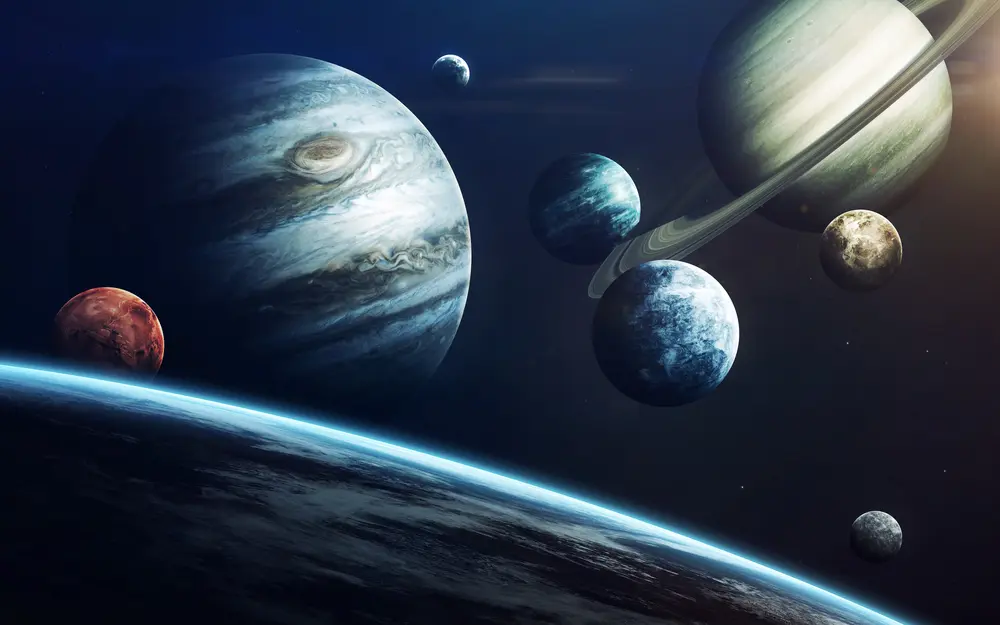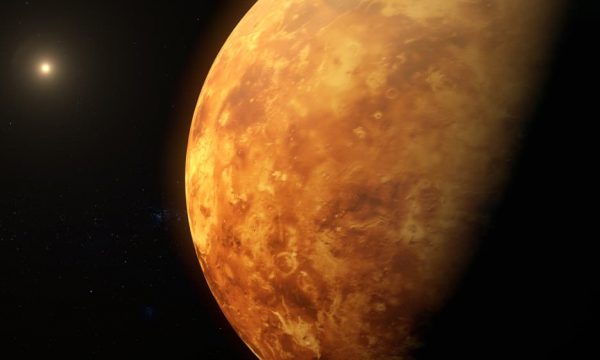
Meet Venus - The Second Planet in The Solar System
Last Updated: November 9, 2023
Many often call Venus, “Earth’s Evil/ Toxic Twin”, but why is that? Why is it a twin to the blue marble we call home? What makes it evil or toxic? Could it be used a second home some day? Let’s dive into Venus!
Introduction to Venus
Venus is the second planet from the Sun, orbiting at a distance of about 67 million miles (108 million kilometers) and our closest planetary neighbor.
Although it has been observed in our sky since ancient times as the “evening star” or “morning star”, it was the first planet to be explored by a spacecraft (NASA’s Mariner 2) in 1962. It was also the site of the first soft landing on another planet in 1970. Since then, it has been explored by multiple probes as well as observed with long-range observatories.
Despite early interest in theories and then popular science fiction about life on Venus in the past, present, or future, the greenhouse effects discovered in the first probe missions quickly stopped these hopes.
Crewed missions to Venus have long been proposed for flyby missions such as gravity assists to travel to Mars and also to study its atmosphere. While no human has traveled past the moon as of 2023, this may change as we set our eyes on Mars and as further research on Venus’s atmosphere trickles in (though any humans would be orbiting Venus instead of landing on it).
Interesting situations and questions which scientists and researchers seek to answer including:
- Will Earth go down the same path as Venus?
- Is there life on Venus? Could something survive in such an extreme environment?
- Global warming research
Information & Quick Facts
- Discovery: The discovery of Venus is not attributed to any specific person because it has been known since ancient times and has been observed by many cultures throughout history.
- Name origin: Roman goddess of love and beauty.
- Type: Terrestrial/Rocky
- Category: Inferior/Inner plannet
- Diameter: 12,104 km (0.95 times that of Earth)
- Mass: 4.87 × 10^24 kg (0.81 times that of Earth)
- Average distance from the Sun: 108.8 million km (0.72 AU)
- Orbital period (year): 224.7 Earth days
- Orbital velocity: 35.02 km/s (21.75 miles/s)
- Rotation period (day): 243 Earth days (retrograde rotation)
- Surface gravity: 8.87 m/s² (0.904 g)
- Surface temperature: average of 464 °C (867 °F)
- Atmosphere: 96.5% carbon dioxide, 3.5% nitrogen, trace amounts of sulfur dioxide, argon, and water vapor
- Surface features: Volcanoes, mountains, and impact craters
- Number of natural satellites (moons): None
- Ring System: None
- Magnetic field: None
- Surface pressure: 90 bar. About 90 times that of Earth’s atmosphere at sea level.
- Reflectivity (albedo): High (about 0.75)
- Exploratory missions: 46
- How long does it take for sunlight to reach it: 6 minutes
- Stargazing observability: Very easy
- Planetary protection: Category 2
- Habitability: Not currently habitable for known forms of life due to extremely high surface temperatures and a toxic atmosphere.
- Potential for human colonization: Low.
- Evidence of current life: None detected to this day.
Physical Characteristics
Size, mass, volume and density
Many of Earth’s physical characteristics are similar to ours. Venus is approximately as big around as Earth at 23,627.4 miles (38,024.6 kilometers) in equatorial circumference, versus 24,873.6 miles (40,030.2 kilometers) for Earth.
Its mass is 81.5% of Earth’s with its volume at approximately 222.7 billion miles (928 billion km) cubed versus our 260 billion miles (1.08 trillion km) cubed. Its density is also similar at 5.243g/cm cubed versus our 5.513g/cm cubed.
Similarly, it gravity is only slightly less than ours at 29.1ft/s (8.87m/s) squared while ours is 32.041ft/s (9.81m/s) squared.
What’s the surface like?
Venus is a rocky planet with a solid surface with numerous volcanoes that are actively spewing debris and smoke into the air. Much of its terrain shows evidence of volcanic activity in the past, but also contradictory and mysterious features that we are still studying.
What about its atmosphere?
An especially thick carbon dioxide atmosphere creates an extreme greenhouse effect. The atmosphere is so thick it creates a pressure of 92 times that of Earth’s at sea level and even 93 times at the surface. This means it would feel like you had 93 clones of yourself on top of you at any given time.
Its similar to the pressure you’d find a mile below the ocean here on Earth. This pressure also turns the air into a supercritical fluid, meaning distinct liquid and gas phases do not exist. It’s somewhere in between a liquid and a gas. However, at altitudes of 30 miles (50 km), pressure, temperature, and radiation is actually similar to Earth’s surface. In fact, recent studies suggest that locations in these altitudes could be favorable for life.
The atmospheric composition is 96.5% carbon dioxide, with the majority of the remaining 3.5% being nitrogen. There are also clouds of sulfuric acid. This richness in primordial noble gases compared to the atmosphere of Earth indicates there was an early change from Earth in evolution.
It is theorized that an unusually large comet impact or seeding from the solar nebula could be the cause. The lack of radiogenic argon indicates that major magmatism shut down early in the planet’s formation. It is also theorized that billions of years ago, Venus’s atmosphere could have been much more like the one surrounding the early Earth.
The evaporation of water from the rising luminosity of the Sun and volcanic resurfacing after a period of 600 million to billions of years, caused the runaway greenhouse effect.
Is there a magnetic field?
Yes, but much weaker than that of Earth, created by an interaction between the ionosphere and solar wind.
Is there water?
It is possible that early in Venus’s history, the planet may have had liquid surface water, even possibly enough for oceans. Advanced greenhouse effects evaporated this water and there are no traces left today according to data so far.
Day and Years or Rotation and Orbit
Despite being about as big as Earth, Venus rotates slowly on its axis. It takes 243 Earth days to rotate on its axis (compared to 24 hours for us), but only 224.7 Earth days to orbit around the Sun, meaning its day is longer than its year. In fact, sunrise to sunset would take 117 Earth days and a year is just under 2 days long on Venus.
In addition to its slow rotation, Venus spins backward compared to Earth meaning the Sun rises in the West and sets in the East. This is why you may see the rotational period or day designated with a negative value. Both its slow rotation and opposite spin have occurred over time thanks to the strong currents and drag of its atmosphere.
Venus’s orbit, especially in comparison to Earth’s is interesting. The orbits of Earth and its twin are the closest between any two planets in our solar system, coming close every 1.6 years, more frequently than any other pair of planets (Mercury on average stays closer to them and any other planet since it is the most central planet with the quickest orbit meaning it meets up with other planets quicker).
Considering how close Venus is to us, it has the lowest difference in gravitational potential compared to other planets, making it an attractive gravity assist waypoint for interplanetary flights, especially in recent years.
Formation and Geology
How did Venus form?
Like the rest of the planets, Venus formed about 4.5 billion years ago in the early formation of the solar system when clumps of gas, dust, and rock began collecting together. It is theorized that Venus experienced impacts of significantly higher velocity than on Earth due to Venus’ faster orbit and closer proximity to the Sun. These impacts created a superheated interior.
What is inside Venus? Is it similar to Earth?
Despite little to no data on its inner structure, due to its similarity in size and density Earth, Venus appears to have a core, mantle, and crust but does not feature plate tectonics like on Earth.
Instead, the superheated interior fuels massive volcanic activity through a cyclical process in which mantle temperatures rise until they reach a critical level that weakens the crust until about 100 million years later when enormous parts of the crust subduct under and back into the mantle, recycling it.
Although a completely solid core cannot be ruled out, what data we do have suggests that Venus’ core is at least partially liquid since the two planets have been cooling at a similar rate. Predicted values suggest a core radius of 1,802 miles to 2,144 miles (2,900 to 3,450 km).
Interesting Topography?
The current understanding is that about 80% of the surface is covered by smooth, volcanic plains, with about 70% of plans featuring wrinkle ridges and 10% with smooth or lobate features. Two highland “continents” make up the rest of its surface area:
- In the northern hemisphere at about the size of Australia, is Ishtar Terra (after the Babylonian goddess of love), the northern continent contains Maxwell Montes, the highest mountain on Venus with its peak at 7 miles (11 km) above the average surface elevation.
- Just south of the equator lies Aphrodite Terra (named after the Greek mythological goddess of love) which is roughly the size of South America and characterized by a network of fractures and faults.
The surface itself is a bit of a mystery. Despite evidence of past and ongoing volcanic activity, there is no evidence of lava flow near any of the visible calderas and few impact craters, meaning that the surface is relatively old, at 300-600 million years old (compared to the Earth’s crust’s average age of about 100 million years). Venus has over 85,000 officially identified and mapped volcanoes, including 167 large ones, that are over 60 miles (100 km) across.
While packed with volcanoes, Venus also features almost a thousand impact craters evenly distributed across its surface. While most other cratered bodies feature degradation (subsequent impacts on the moon and erosion here on Earth), about 85% of Venus’s craters are in pristine condition. This indicates there was a global resurfacing event 300-600 million years ago and there has been a decrease in volcanism since then since these craters are in such good condition.
In addition to the typical impact craters, mountains, and valleys on rocky planets, there are features that are volcanic in origin (tessera terrains) including:
- Flat-topped volcanic features called “farra” which look like pancakes ranging in size from 12-31 miles (20-50 km) across and 330-3,280 feet (100-1,000 meters) high
- Radial fracture systems called “novae” that look like stars
- Spiderweb-like fractures with both radial and concentric fractures known as “arachnoids”
- Circular rings of fractures sometimes surrounded by a depression known as “coronae”
The oldest tessera terrains seem to feature igneous rocks that are rich in feldspar and quartz (known as felsic) based on consistently lower thermal emissions (detected by Venus Express and Magellan). These are particularly interesting since felsic crust usually requires the presence of oceans made of water and plate tectonics, again leading to conclusions that Venus may have once had large bodies of surface water.
Most surface features are named after historical and mythological women such as Ariadne Crater named after the wife of Dionysus which serves as the prime meridian of the planet and Sedna Planitia named after the Inuit sea goddess located south of Ishtar Terra.
The exceptions are Maxwell Montes (named after Scottish physicist James Clerk Maxwell) and highland regions Alpha Regio, Beta Regio, and Ovda Regio which were all discovered and named by Richard Goldstein in 1964 before the current system was adopted by the International Astronomical Union, which oversees the naming of astronomical objects and features.
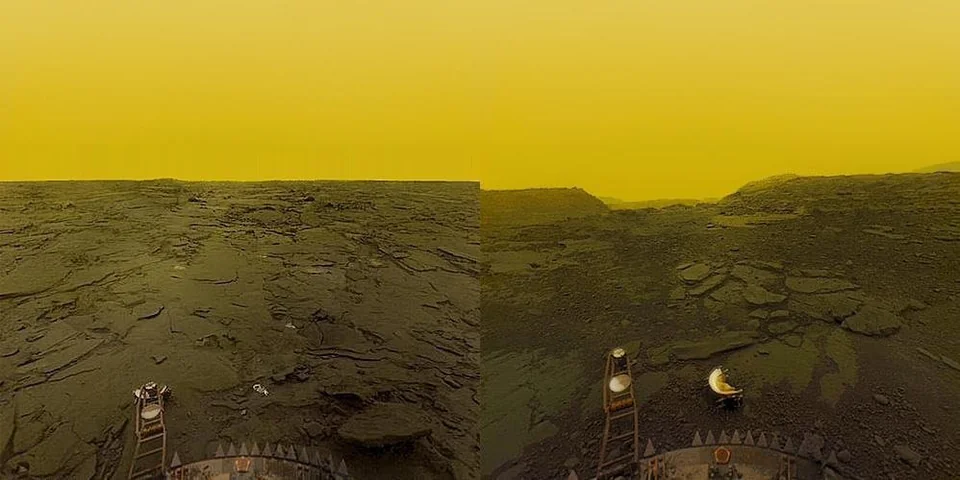
Climate
Temperatures
Due to the thick atmosphere and advanced greenhouse effect, Venus is the hottest planet in the solar system with an average temperature of 867 F (464 C, 737 K) despite being almost double Mercury’s distance from the Sun, and only receiving 25% of the sunlight Mercury does.
In fact, the coldest recorded surface temperature is 715 F (380 C) at Maxwell Montes, the highest point on Venus, meaning there is little variation in temperature on the surface, in the two hemispheres, and day versus night side of the planet (even despite the solow rotation).
Weather
Venus has been identified by scientists such as Carl Sagan as a warning and research object linked to climate change on Earth due to its advanced greenhouse state. While the wind speed at the surface is slow (a few km per hour), the atmospheric density means they exert tremendous force against objects, transporting dust and small stones over the surface easily, making even walking conditions for humans difficult (before we even factor in heat, atmospheric pressure, and toxic atmosphere).
Above the carbon dioxide layer are thick clouds of mainly sulfuric acid with approximately 1% ferric chloride. These thick clouds reflect about 70% of the sunlight that fals on them back to space and cover the whole planet (obscuring visual observation of its surface) and meaning only 10% of the received sunlight reaches the surface, similar to an Earth day with overcast clouds.
Winds at the top of the clouds reach 185 mph (300 km/h), circling Venus in about 4-5 Earth days, and moving up to 60 times the speed of its rotation (comparably, Earth’s fastest winds are only 10-20% of its rotation speed).
There is controversial and contradictory evidence for lightning in the atmosphere. There were suspected bursts detected by the Soviet Venera probes and the Venus Express detected whistler mode waves which are signatures of lightning.
These intermittent appearance indicates it’s related to weather activity, but at about hlaf the rate on Earth. And yet other instruments have detected no lightning. So it’s unclear on if it exists and if it does, whether it originates from weather or volcanoes.
An atmospheric polar vortex was detected in the South Pole in 2007 by the Venus Express probe. In addition, an ozone layer was detected high in the atmosphere in 2011, also by Venus Express.
The ionized (where atoms or molecules change their positive or negative charge by gaining or losing electrons) part of the atmosphere streams out similar to the ion tail of a comet
Seasons
Venus’s axial tilt is very small at only about 3 degrees, meaning it doesn’t exactly experience seasons, but much milder, less drastic changes than for Earth, usually described as a cyclical variation in sunlight absorption by the atmosphere, possibly caused by particles in the upper clouds.
Venus’ orbital parameters
Orbital parameters describe the way objects move around in space, such as planets, moons, and satellites. These parameters include the size, shape, and tilt of the orbit, as well as the object’s position and speed within the orbit.
They help scientists understand and predict the paths of celestial bodies, which is crucial for planning space missions, observing astronomical phenomena, and monitoring satellites.
| Orbital Property | Explanation | Venus | Earth | Ratio (Venus/Earth) |
|---|---|---|---|---|
| Semimajor axis (106 km) | Avg. distance from the Sun | 108.210 | 149.598 | 0.723 |
| Sidereal orbit period (days) | Time for one orbit relative to fixed stars | 224.701 | 365.256 | 0.615 |
| Tropical orbit period (days) | Time for one orbit relative to the vernal equinox | 224.695 | 365.242 | 0.615 |
| Perihelion (106 km) | Closest distance to the Sun | 107.480 | 147.095 | 0.731 |
| Aphelion (106 km) | Farthest distance from the Sun | 108.941 | 152.100 | 0.716 |
| Synodic period (days) | Time to return to the same position relative to the Sun | 583.92 | – | – |
| Mean orbital velocity (km/s) | Avg. speed while orbiting the Sun | 35.02 | 29.78 | 1.176 |
| Max. orbital velocity (km/s) | Highest speed in the orbit | 35.26 | 30.29 | 1.164 |
| Min. orbital velocity (km/s) | Lowest speed in the orbit | 34.78 | 29.29 | 1.187 |
| Orbit inclination (deg) | Angle between the orbital plane and the ecliptic plane | 3.395 | 0.000 | – |
| Orbit eccentricity | Deviation of orbit shape from a perfect circle | 0.0068 | 0.0167 | 0.407 |
| Sidereal rotation period (hrs) | Time for one rotation relative to fixed stars | -5832.6 | 23.9345 | 243.690 |
| Length of day (hrs) | Time for one rotation relative to the Sun | 2802.0 | 24.0000 | 116.750 |
| Obliquity to orbit (deg) | Angle between the equatorial plane and orbital plane | 177.36 | 23.44 | – |
| Inclination of equator (deg) | Axial tilt of the planet | 2.64 | 23.44 | 0.113 |
Exploration of Venus
| Mission Name | Mission Log Dates | Notes |
| Venera program (Soviet Union) | 1961-1984 | Series of 16 missions to study Venus’ atmosphere, surface conditions, and geological features; 13 of these successfully entered the atmosphere; 10 landed on the surface, but only survived for short periods (23 minutes to 2 hours); established a number of precedents in space exploration |
| 1975-1982 | Landers revealed images of a surface covered in sediment and relatively angular rocks | |
| Mariner 2 (NASA) | Launch: Aug 27, 1962 | 1st successful mission to reach another planet (Venus) |
| Flyby: Dec. 14, 1962 | Discovered it was far hotter and inhospitable than previously thought; launched just over a month after the loss of Mariner 1 which suffered a software glitch and required its destruction shortly after launch due to being out of control; 42-minute scan during the flyby; Temperature readings confirmed no significant variation across the planet; no discernable magnetic field, likely due to the distance to the planet | |
| Mariner 5 (NASA) | Launch: Jun. 14, 1967 | Originally built as a back up to Mariner 4 (successful Mars mission) and remodified for Venus; |
| Venus Flyby: Oct. 19, 1967 | Closest approach at 2.544 miles (4,094 kilometers); no magnetic field but dense daylight ionosphere produces a bow shock that deflects solar wind around the planet; hydrogen corona (found by Soviet Venra 4); no oxygen emission; temperature readings countered the Soviet claim that their Venera 4 had transmitted from the surface | |
| End: Nov. 5, 1968 | After the flyby, it entered solar orbit between 0.58 and 0.74 AU; contact was intermittent from Dec. 1967 and NASA officially stopped attempts to communicate almost a year later | |
| Mariner 10 (NASA) | Launch: Nov. 3, 1973 | Although its main mission was to study Mercury, it also studied Venus during the gravity assist |
| Venus Flyby: Feb. 5, 1974 | 4,165 photos of Venus including the first showing the day-night terminator; closest range at 3,584 miles (5,768 kilometers) | |
| End: Mar. 24, 1975 | ||
Pioneer Venus 1 (NASA) | Launch: May. 20, 1978 | The first of a two-spacecraft orbiter-probe combination designed to study Venus’s atmosphere; First American spacecraft to orbit Venus (about 3 years after the Soviets did) |
| Venus Orbit Insertion: Dec. 4, 1978 | Mapped the surface with radar finding it to be generally smoother than Earth though with a mountain higher than Everest (Maxwell Montes, at about 6.5 miles/ 10.8 kilometers) and chasm deeper than the Grand Canyon; confirmed very little if any magnetic field and clouds of sulfuric acid | |
| End: Oct. 8, 1992 | Burned up in the atmosphere after a successful 14-year mission originally planned for only 8 months | |
Pioneer Venus 2 (NASA) | Launch: Aug. 8, 1978 | Sistership to Pioneer Venus 1 consisting of the main spacecraft, a large probe, and three identical smaller probes designed to collect data as they descended toward the surface 2 probes survived landing and 1 transmitted data from the surface for 67.5 minutes |
| Large Probe Release: Nov. 16, 1978 | About 7 million miles (11.1 million kilometers) from the planet | |
| Small Probes Release: Nov. 20, 1978 | About 6 million miles (9.3 million kilometers) from Venus | |
| End/ Arrival date: Dec. 9, 1978 | All probes breached Venusian atmosphere, with Large Probe entering first, all took a little over an hour to reach the surface despite the fact the large probe had a parachute; Surprisingly 2 of the small probes survived impact, which was unexpected; mapped out the atmosphere particularly relating to convection | |
| Magellan (NASA) | Launch: May 4, 1989 | Mapped about 98% of Venus’ surface (1st spacecraft to do it) using radar in 1990-1991 showing evidence of extensive volcanism and recent eruptions due to sulfur in the atmosphere; one of the most successful deep space missions |
| Deployment from Space Shuttle Atlantis: May 5, 1989 | ||
| Venus Orbit Insertion: Aug. 10, 1990 | Communications outages sporadically until software was uploaded to reset the system when these anomalies occurred; September 1990 it began returning detailed radar images and elevation data of Venus’ surface, showing evidence of volcanism and turbulent surface winds; mapping continued right up to the end | |
| End: Oct 13, 1994 | Burned up about 10 hours after descending into the atmosphere; 1.200 gigabits of data, exceeding the 900 gigabits of data from all NASA planetary missions combined at the time; found that at least 85% of its surface is covered with volcanic flows with little erosion due to the lack of water | |
| 2023 revaluation of data | Computer simulations confirmed topography of Maat Mons had changed during an 8-month interval, concluding active volcanism as the cause | |
| Venus Express (ESA) | Launch: Nov 9, 2005 | 1st European spacecraft to orbit Venus; original mission was expected to last no more than 500 Earth days; Studied Venus’ atmosphere, plasma environment, climate, and surface conditions |
| Venus orbit insertion: April 11, 2006 | Investigated the planet’s dense atmosphere and its interaction with the solar wind; complete temperature map of the southern hemisphere by Dec. 2006; evidence for past oceans on the surface; lightning observations; double atmospheric vortex at the south pole | |
| 2008-2009 | 1st direct evidence for ongoing volcanism: 4 transient localized infrared hot spots in the Ganis Chasma rift zone, suggesting lava freshly released by volcanic eruptions. | |
| End: Dec 16, 2014 | Routine science experiments concluded in May a as propellant began to run low; Contact lost in late November; mission officially ended on Dec. 16, but a carrier signal was detected through January 2015, suggesting it technically burned up then | |
| Akatsuki (JAXA) | Launch: May 20, 2010 | A.k.a. the Venus Climate Orbiter |
| Arrival: Dec 7, 2015 | Studies Venus’ atmospheric dynamics, cloud structure, and meteorology | |
| In late 2015 and early 2016, observed bow shapes in the atmosphere indicating perhaps the largest stationary gravity waves in the solar system. |
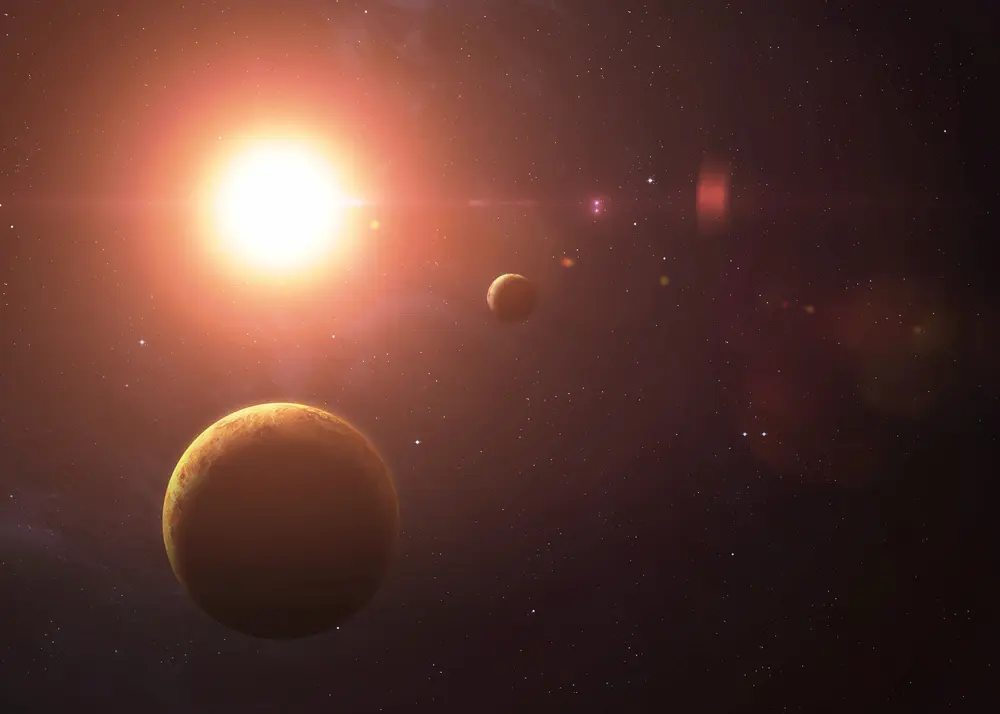
Due to recent studies and observations that have increased the chance of finding the first sign of life off of Earth in the form of microbes in the atmosphere of Venus, three new missions have been approved for launch in the next decade, but dates have not been confirmed.
Named after Renaissance artist and scientist Leonardo da Vinci, NASA’s DAVINCI mission (Deep Atmosphere Venus Investigation of Noble gases, Chemistry, and Imaging) will study the origin, evolution, and present state of our sister planet from both an orbiter and atmospheric probe. It is scheduled to launch in 2029.
The joint ESA-NASA EnVision mission aims to provide a detailed study of the interaction between the planet’s atmosphere, surface/subsurface, and interior, creating a holistic view of its history, activity, and climate. It is scheduled to launch in 2030.
NASA’s VERITAS “Venus Emissivity, Radio Science, InSAR, Topography, and Spectroscopy” will be an orbiter focused on discovering how the evolution of Earth and Venus differed, leading to their very different present environments as well as providing detailed present-day observations of volcanic activity and searching for water. It is scheduled to launch in 2031.
Venus in Popular Culture
Venus itself is named after the Roman goddess of love, beauty, desire, prosperity, victory, and reproduction. Her son, Aeneas, survived the fall of Troy and fled to Italy, founding Rome. His way was lit by her heavenly form, the morning star (the planet Venus), shining even in the daylight according to Virgil’s telling of the founding of Rome.
Julius Caeser claimed her as an ancestor. She was central to many religious festivals and was one of the revered gods of Rome, the central figure of many cults. They adapted the Greek counterpart Aphrodite for much of her presence in art and literature. Over time, she has become one of the most widely referenced deities of Greco-Roman mythology, particularly as the embodiment of love and sexuality.
Venus’s origin is merged with Aphrodite’s, saying that she emerged in adult form from the sea foam from the severed loins of the god of the sky (Caelus in Roman and Uranus/ Ouranos in Greek).
Venus is the balance to her male counterparts, Vulcan the god of fire and Mars the god of war. She was seen as the yielding, watery female principle, but also embodies seemingly contradictory ideas such as military victory, good fortune and prosperity, and sexual success.
She is mother to the Cupid, with his father being Mercury, Vulcan, or Mars, depending on the origin story, and we often see child-like winged figures accompanying Venus or off creating love in the world to symbolize her son.
Like many of the other planets, Venus has had an impact on much of pop culture including literature, film, television, and other media
Literature
In addition to her numerous citations in mythology, the mysterious closest planet to us has been used in fiction since ancient times through today including
- Homer of “The Illiad” and “The Odyssey” called it the most beautiful star in the sky.
- For science fiction, Venus has been prominent since before the 19th century, primarily allowing science fiction writers to speculate about what could be hidden under its clouds. The first official use of it as the primary setting was Voyage à Venus (Voyage to Venus, 1865) by Achille Eyraud, but was one of multiple planetary settings in the solar system in earlier works.
- Early pulp science fiction (1930s-1950s) often featured it as a jungle (i.e. “In the Walls of Eryx” by H.P. Lovecraft and Kenneth Sterling in 1936), an ocean planet (with notably “Clash by Night” by Lawrence O’Donnell in 1943 and its sequel novel Fury), a swampland (notably Edgar Rice Burroughs’s Amtor series beginning with Pirates of Venus in 1932), or a desert (notably Arthur C. Clarke’s “Before Eden”) often inhabited by monsters including dinosaur-like creatures. Native sentient inhabitants were often gentle, heavenly, and beautiful due to associations with the Roman goddess.
- Once the reality of the planet’s toxic surface became known, these ideas mostly shifted to represent this accurately, using it as a setting to discuss climate change and environmental concerns, or utilizing planet terraforming and colonization. However, leading experts in literature and science fiction have noted how few Venus stories there are compared to Mars, even though they are both just one planetary hop away.
- Australian author Shirley Hazzard won the 1980 National Book Critics Circle Award for fiction for her book The Transit of Venus about two orphaned sisters.
- John Gray is also famous for using two planets to explain relationships in Men Are From Mars, Women Are From Venus.
TV and Film:
Venus has been used in various TV shows and films, including
- In the Disney film, The Princess and the Frog, Ray the firefly falls in love with the evening star, Venus, mistaking it for another firefly
- “The Outer Limits” episode “Cold Hands, Warm Heart” in 1964 features sentient plant life on Venus
- The films Abbott and Costello Go to Mars (1953) and Queen of Outer Space (1958) feature the trope of Venus being populated by beautiful women
- Voyage to the Planet of Prehistoric Women (1968), portrays the Venusians as “half-naked sex-appealing blond sirens” with supernatural or psychic powers.
- Ray Bradbury’s short story “The Long Rain” (1950) depicts Venus as a planet with incessant rain, and was adapted to film in The Illustrated Man (1969)
- The anime film Venus Wars (1989) shows the terraforming of the planet through a comet impact
- In the anime television show “Cowboy Bebop”, it shows terraforming the planet by introducing plant life to create a breathable atmosphere
- In the film 20 Million Miles to Earth (1957), a Venusian monster attacks humans
- The Soviet film Planeta Bur (1962) features an American–Soviet joint scientific expedition to Venus
- The Polish–East German film The Silent Star (1960) based on Stanisław Lem’s novel The Astronauts (1951) had an expedition to Venus discover the ruins of past sentient life (Fun Fact: another of Stanisław Lem’s works was adapted to create the classic sci-fi film Solaris which you can find out more about in our article about astronaut movies)
- The British film Stranger from Venus (1954) was essentially the Venus version of The Day the Earth Stood Still (1951)
- Target Earth (1954) shows visitors from Venus wanting to conquer Earth
Comics:
Venus has been a popular backdrop and inspiration for comics including
- Venus is a character in the Marvel Comics Universe (first appearing in 1948), originally based on the goddess from Greek and Roman mythology, but it is later revealed she is a siren
- Superman comic book story “The Three Tough Teen-Agers” in 1962 features sentient plant life on Venus
- A sentient Venusian worm appears as a supervillian in Captain Marvel comics
- Marvel Comic’s Sub-Mariner defended Earth from an amphibious Venusian invasion i
- An Earth Man on Venus in 1950 featured exotic Cenusian life like giant ants
- The Treens in the Dan Dare comics (launched in 1950) are kidnapped humans that have been genetically engineered to survive on Venus
- Several of DC Comics’ Wonder Woman stories in the 1940s featured her female allies from Venus
Video Games
- The mysterious twin world has been a setting for games such as Transhuman Space, Battlezone, and Destiny.
Music
- Teen idol Frankie Avalon’s first Number 1 hit in 1959 was “Venus”
- In 1969, a different song by the same name by the Dutch rock band Shocking Blue topped the charts
- In 1986, British pop band Bananarama covered that song which became a Number 1 hit in the U.S.
Venus stems from a Proto-Italic form “wenos” for desire, which stems from the Proto-Indo-European “wenh-os”, the Messapic Venas, and the Old Indic vánas. Derivatives include “venustus” meaning attractive or charming, venustas meaning charm or grace, venerius meaning of Venus or erotic, venerare meaning to adore/ revere/ honor/ venerate/ worship, and veneratio meaning adoration.
Observing Venus in the Night Sky
In planetary observing, there are a couple of terms that are important to remember since we have to consider the location of the desired planet, the Sun, and the Earth to understand how and when the planet will be visible and how.
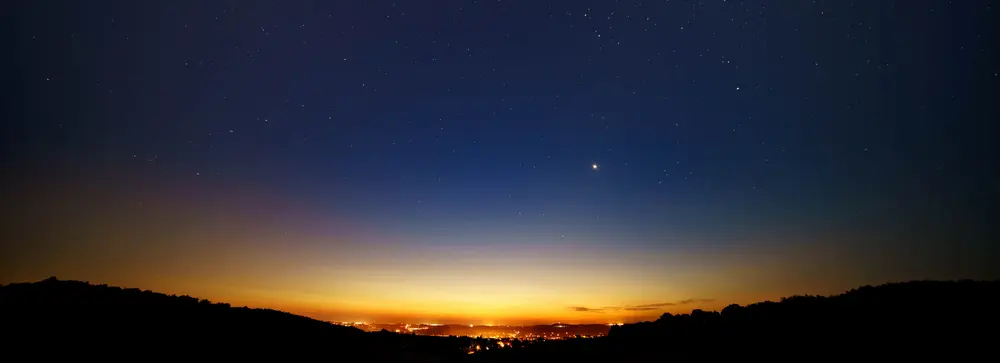
First, astronomers typically group the planets into two subsets to determine their viewing schedule:
Superior Planets: those past Earth going away from the Sun meaning Mars and beyond
Inferior Planets: the two planets closer to the Sun than the Earth (Mercury and Venus)
Then we look at the location of the desired planet, Earth, and the Sun with a few line-ups that determine their visibility:
Planetary Opposition occurs when a planet is directly opposite the Earth from the Sun meaning that they line up with the Earth between the Sun and the other planet. This is typically the best time to view the planets as it is when they will appear the brightest since the planet is the closest to Earth and fully illuminated by the Sun. Only superior planets experience oppositions while inferior planets experience 2 conjunctions.
Conjunction occurs when a planet is directly in line with the Sun from the Earth meaning the Sun lies directly in between the 2 planets for superior planets. For inferior planets, like Venus, we see the following interactions.
- Superior Conjunction is when the planet is on the opposite side of the Sun from the Earth (behind the Sun from our perspective). The planet appears as a full disk like a full Moon, but smaller since it is further away.
- Inferior Conjunction is when the planet is on the same side of the Sun as the Earth, meaning they are in front of the Sun from our perspective. The planet disappears as a new Moon and as a large thin crescent just before and after.
- Greatest Elongation is when the planet is at its greatest observed angle between it and the Sun when viewed from the Earth. It appears as a half circle like a first or third quarter Moon. This occurs both in the eastern and western sky. Greatest Elongations are the best and safest time to observe Venus. Otherwise, it is too close to the Sun and you can harm your eyes by staring close at the Sun. Make sure that you have a solar filter on telescopes or binoculars to protect yourself.
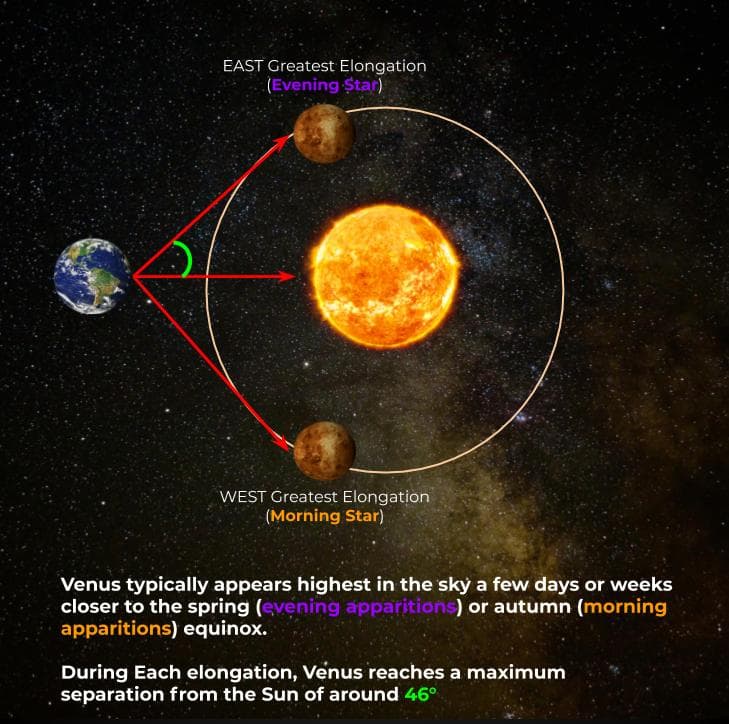
In between the conjunctions, Venus waxes and wanes like our Moon and appears higher or lower in the sky. When Venus moves from Superior conjunction (behind the Sun), it travels left/ east relative to the Sun and begins to rise in the western horizon before sunset, continuing to appear higher in the sky each night, and going through the waning phases (growing smaller and smaller from the fully illuminate disk at superior conjunction).
It eventually reaches its greatest eastern elongation and appears as a half circle near its peak height in the evening sky. It continues closer to Earth, lower in the sky as a crescent.

It then reaches inferior conjunction in front of the Sun similar to a new moon before waxing (growing) into a crescent again as it moves to the right/ west relative to the Sun and rises in the eastern horizon before sunrise. At its greatest western elongation, it appears as a half circle, again near its peak height in the morning sky. As it moves further away from the Earth, it becomes dimmer and continues through the waxing phases until it is again at superior conjunction, beginning the cycle once again.
Upcoming greatest western elongations (best morning visibility, rising in the east before the sun)
October 23, 2023: magnitude of -4.4 and appears 50% illuminated (relatively small this year)
Upcoming greatest eastern elongations (best evening visibility, setting in the west after the sun)
We just missed it on June 4th this year but it was relatively small.
The next, January 10th, 2025 will be relatively large.
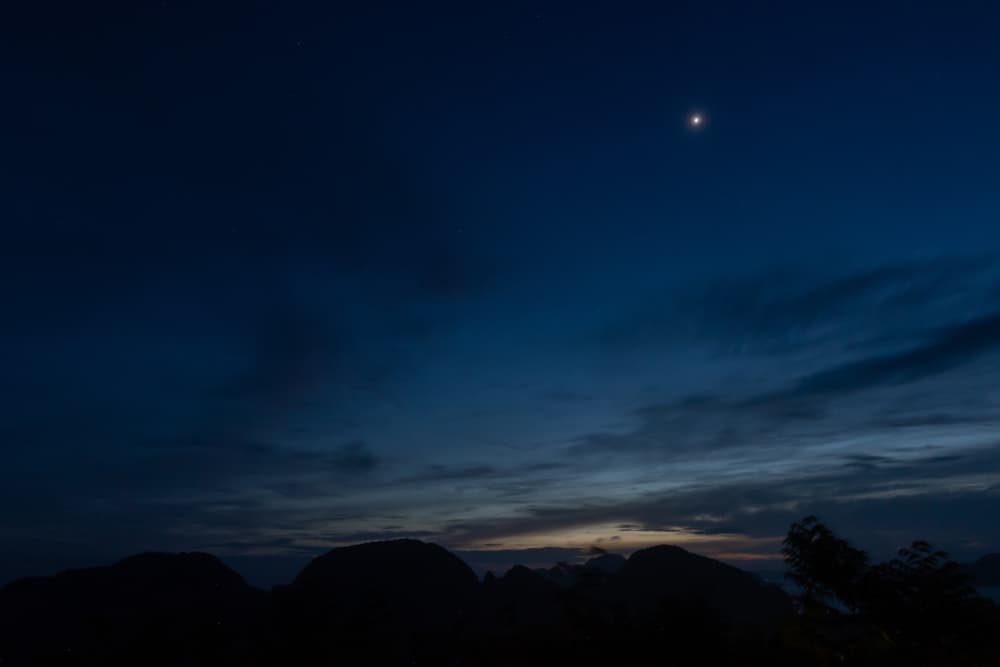
Conjunctions with other planets
Unfortunately, we’ve already missed the Venus conjunctions with other planets for 2023 though there was a particularly wonderful one with Jupiter in March.
2024 Venus Conjunctions with other planets
February 22nd with Mars
March 21st with Saturn
April 3rd with Neptune
August 6th with Mercury
Transits
Like Mercury, Venus will rarely pass in front of Earth at the right time so that observers on Earth see it pass across the Sun as a shadow called a transit, but transits of Venus are amonth the rarest of predictable astronomical phenomena.
They occur in a pattern that repeats generally every 243 years, with a pair of transits 8 years apart in December followed by a gap of 121.5 years, then another pair eight years apart in June followed by another gap of 105.5 years.
The last Venus transit was on June 5th, 2012 and the next will not happen until 2117!
Summary and Future Prospects
Venus is a bit of an enigma. So close and yet so hard to read. So similar to us and yet so drastically different, to the point of toxic. While Venus has waxed and waned, in its phases and in its popularity both from the general public and scientific interest, it’s certainly intriguing.
As the closest planet it to us, it intrigues us and perhaps provides clues about both our past and our future. Despite its extremely toxic environment, it may actually host the possibility of life, not just in the past or future, bur even today in the form of single-celled organisms in certain altitudes of its atmosphere.
It continues to provide answers and questions, though we hope the upcoming missions will help us to better understand our closest neighbor.
Fun Facts About Venus
- Venus has the densest atmosphere of all the rocky bodies in the solar system.
- Since it is often visible near the Sun either during the day, directly before/ after sunset, or directly before/ after sunset, it is often referred to as a “morning star” or “evening star” both in ancient times and today.
- Venus is the third brightest object in Earth’s sky after the Moon and the Sun.
- Venus is one of only two planets in our solar system that have no moons.
- Venus has the longest solar day in the solar system at 117 Earth days.
- “Snow” has been observed on Venus’s Maxwell Montes from a substance (potentially elemental tellurium or lead sulfide/ galena) which like our snow, rises in gas form to higher elevation where it is cooler and precipitates.
- Surface temperatures are hot enough to melt lead and its sulfuric acid clouds smell like rotten eggs!

Sarah Hoffschwelle is a freelance writer who covers a combination of topics including astronomy, general science and STEM, self-development, art, and societal commentary. In the past, Sarah worked in educational nonprofits providing free-choice learning experiences for audiences ages 2-99. As a lifelong space nerd, she loves sharing the universe with others through her words. She currently writes on Medium at https://medium.com/@sarah-marie and authors self-help and children’s books.
Wow! There's more to read 🚀
This page is part of our collection of astronomy articles. If you enjoyed the read, then you’ll love the following articles.
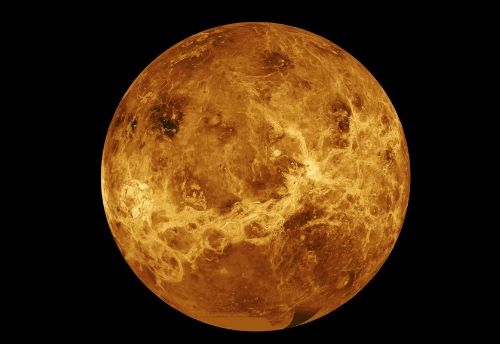
Looking for the real-time distance between Earth and Venus? Find out the current distance of Venus with our reliable and accurate tracker.
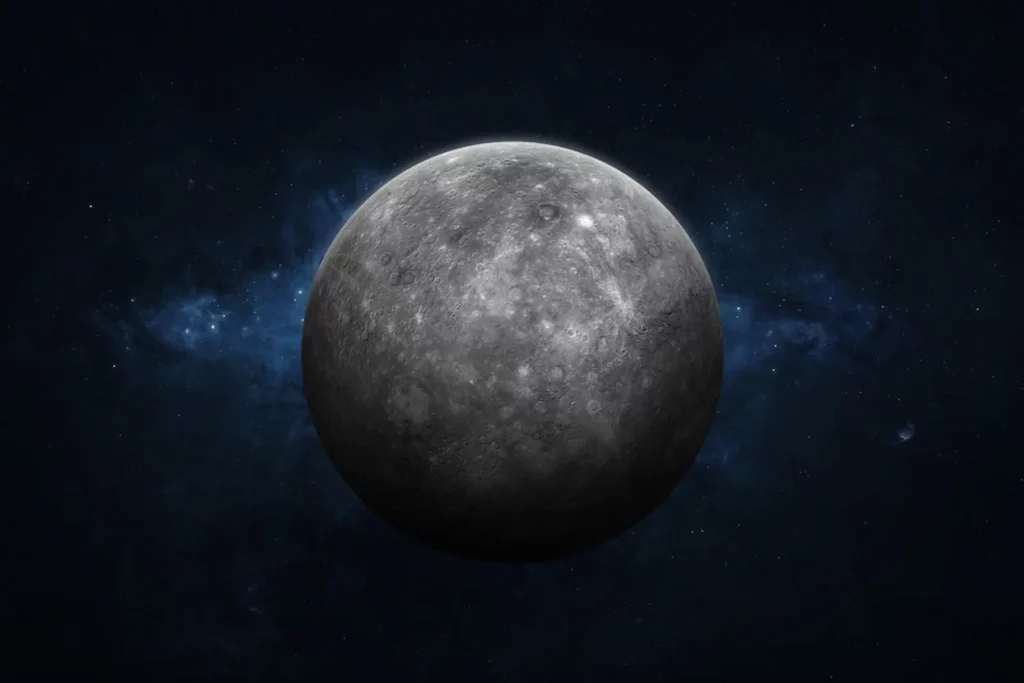

Mars is among the most popular planet to observe in the night sky. Here are a few tips and tricks on observing Mars through a telescope.
